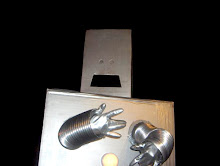 Yesterday I pointed out that statistically, more people have been crushed to death by vending machines than killed by swine flu this year. Wait, stop dialing. I'm not calling for an all-out panic on vending machines. I'm using it as an excuse to talk about free sampling.
Yesterday I pointed out that statistically, more people have been crushed to death by vending machines than killed by swine flu this year. Wait, stop dialing. I'm not calling for an all-out panic on vending machines. I'm using it as an excuse to talk about free sampling. To my knowledge, free sampling is a popular mechanic for generating product trial and has killed no one this year. But here's the secret truth about free sampling - the thing they don't tell you. When marketers offer free samples they're hoping to cannibalize you away from whatever brand you're already using, stealing away your loyalty by changing your preference, AND they're hoping you'll unconsciously purchase their product faster than your normally would, even if your need for it isn't totally immediate! Wait, that doesn't sound all that evil either.
Okay, so what do vending machines and free samples have in common? Last time you checked, your relationship with your vending machine was "you eat my money, I'll eat your snacks". Well meet the BooBox. Belgian designers Fosfor have created a machine that spits out different trial-sized samples of good. It can even handle chilled items.
Both marketers and actual people are always looking for more experiential ways to generate trial and move samples from cargo van (A) to shopping list (B). To date the delivery has been fairly one-sided, either through direct-to-home mailings or interception teams in stores or on the street. Delivery systems like the BooBox put the sampling decision in the consumer's hands, but unlike calling or emailing for a redemption, the pay-off is almost immediate. All you do is send out a text on your phone and they fire back an PIN number for free goods. Boo(m)! A more interesting vending and sampling experience signed, sealed and delivered.
So where's the evil? You fell right into their hands.
 Creating peripheral promotional offerings to help boost your new brand or product isn't easy, but it's cool. It's really cool. Toyota is unleashing their newest microcar, a tiny little number called the "iQ". This tiny torpedo seats four and eats up a mere 118 inches of roadspace, which is easy when everyone is sitting on everyone else's lap. What? Oh, it apparently actually does have four seats. Oh. In the video we only really see two designers and a racecar driver slash honoury designer perform the clown car trick, so you will have to forgive me.
Creating peripheral promotional offerings to help boost your new brand or product isn't easy, but it's cool. It's really cool. Toyota is unleashing their newest microcar, a tiny little number called the "iQ". This tiny torpedo seats four and eats up a mere 118 inches of roadspace, which is easy when everyone is sitting on everyone else's lap. What? Oh, it apparently actually does have four seats. Oh. In the video we only really see two designers and a racecar driver slash honoury designer perform the clown car trick, so you will have to forgive me.





















